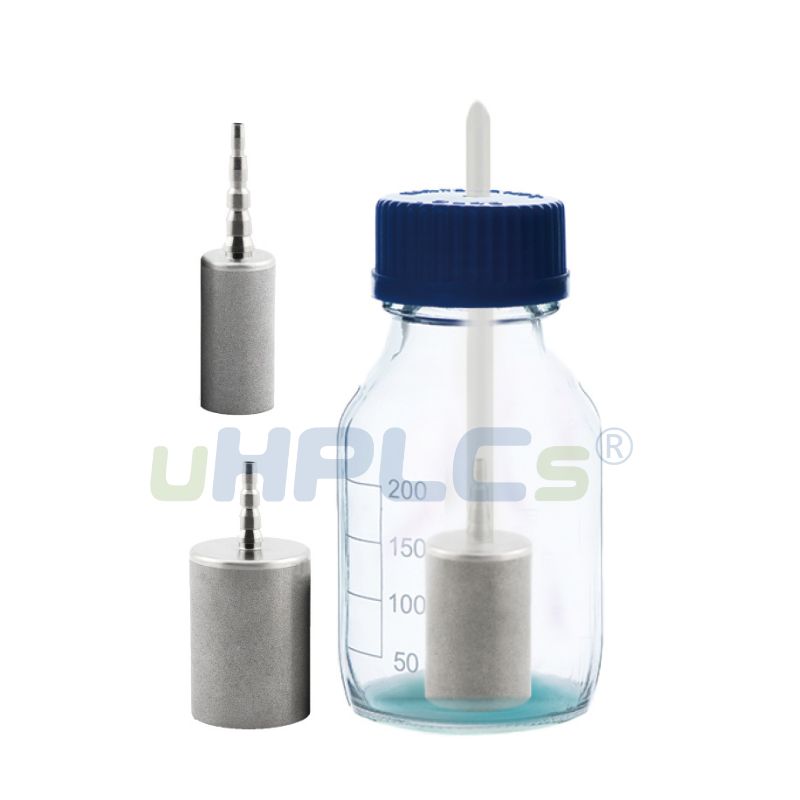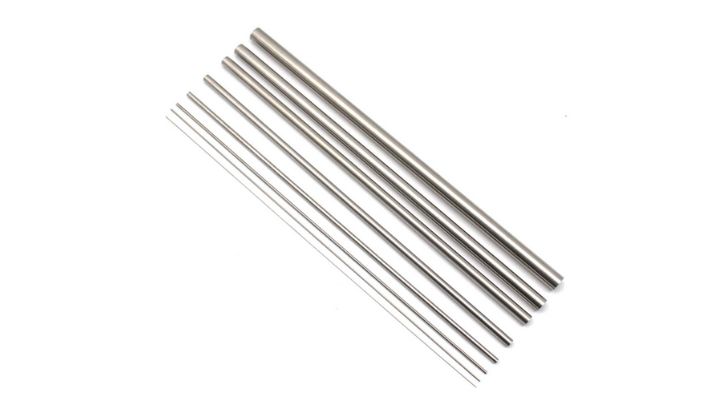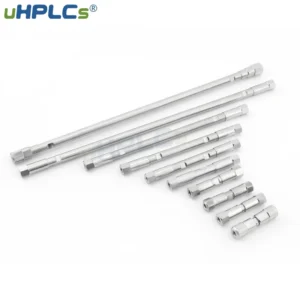How to Improve Your HPLC Column Efficiency
High-performance liquid chromatography (HPLC) plays a critical role in analytical laboratories for the separation, identification,
Home » Inlet Solvent Filter -ID Tubing
Solvent filters are essential in any Ultra High-Performance Liquid Chromatography (UHPLC) system. These filters help to protect the system from any impurities that may be present in the solvent used in the process, thereby ensuring the accuracy and reproducibility of results.
Solvent filters ID Tubing is one of the leading manufacturers of inlet solvent filters for HPLC systems. With years of experience in the industry, ID Tubing has developed a reputation for producing high-quality filters that deliver exceptional performance and reliability.
One of the key features of ID Tubing’s inlet solvent filters is their use of ultra-high molecular weight polyethene (UHMWPE) materials. This material has excellent chemical resistance and durability, making it ideal for HPLC systems. The filters are designed to withstand high pressure and provide excellent particle retention capabilities, ensuring the system remains free from impurities and contaminants.


Pore Size : 2μ,5μ,10μ,20μ
Size Option
1) Option A (multi-stage joint)
ID Size: 1.5-2.2-3
Size: D12. 7* L 28.5
2) Option B
ID Size: 2-2.5-3 (multi-stage joint)
Size: D12. 7* L 28.5 ; D19. 7* L 30.0
3) Option C
ID Size: 1.5-1/16“ ;2.2-3.0-1/8“ ; 3.5-Multi-stage Joint
Size: D12. 7* L 28.5 ;
4) Option D
ID Size: 1/8“-1/16“-3/16“ (3.0-4.0-5.0) -(multi-stage joint)
Size: D25* L 35 ;
Pore Size : 2μ,5μ,10μ,20μ
Tubing Size :
1.) 1 / 16″ – D10.0 * L19.5; D12.7 * L28.5;
2.) 1 / 8″ – D12.0 * L20.0; D16.0 * L32.0;
3.) 1 / 6″ – D25.0 * L52.7;
* Item number: 700003616
* Brand: Waters
Pore Size : 2μ,5μ,10μ,20μ
Tubing Size : 1.) 1 / 16″ – D10.0 * L19.5; D12.7 * L28.5; 2.) 1 / 8″ – D12.0 * L20.0; D16.0 * L32.0; 3.) 1 / 6″ – D25.0 * L52.7;
Pore Size : 2μ,5μ,10μ,20μ
Tubing Size :
1.) 1 / 8″ – D12.7. * L28.5; D19.7 * L30.0;
2.) 3/ 16″ – D25.0 *L30.0; D25.0 * L40.0;
Pore Size : 2μ,5μ,10μ,20μ
Tubing Size : 1 / 8″
Size: D23.5* L5.4
OEM Size Available
* Item number:AG01018-60025
* Brand:Agilent Technologies
Pore Size : 2μ,5μ,10μ,20μ
Tubing Size : 1 / 8″ (3-steps )
Size: D23.5* L5.4 OEM Size Available
* Item number:AG01018-60025
* Brand:Agilent Technologies
Get More Details of HPLC Products by 2023 New E-Catalogue from uHPLCs
Here are some of the main features of Inlet Solvent Filter – ID Tubing:
1. High-quality materials: ID Tubing uses ultra-high molecular weight polyethylene (UHMWPE) materials that provide excellent chemical resistance and durability, ensuring the filters can withstand high pressure and provide excellent particle retention capabilities.
2. Particle retention: The filters are designed to effectively capture and retain any impurities and contaminants that may be present in the solvent, ensuring the accuracy and reproducibility of results.
3. Versatile configurations: ID Tubing’s inlet solvent filters come in various sizes and configurations, making them suitable for use in various uHPLC systems.
4. Easy to install and replace: The filters are designed for easy installation and replacement, ensuring that they do not cause any downtime in the process.
5. Exceptional customer support: ID Tubing’s team of experienced professionals can help customers choose the right filters for their specific needs and provide guidance on their use and maintenance.
6. Compatible with various solvents: The filters are compatible with various solvents, making them suitable for use in a range of applications.
7. Wide range of applications: ID Tubing’s inlet solvent filters are suitable for use in various industries, including pharmaceuticals, biotechnology, and food and beverage analysis.
Are you looking for a reliable OEM supplier for your Inlet Solvent Filter needs? Look no further than uHPLCs! Our team of experts is proud to offer a range of special Inlet Solvent Filter services to meet your specific requirements. With years of experience in the industry and state-of-the-art manufacturing facilities, we’re committed to delivering high-quality products and exceptional service to our customers. Contact us today to learn more about our OEM Special Inlet Solvent Filter Service and how we can help you with your next project. Don’t settle for anything less than the best – choose uHPLCs for all your Inlet Solvent Filter needs!

High Quality HPLC Column 316L, 316 Stainless Steel Tube Materials

Design New HPLC Columns 100% As Clients Request

Make HPLC Column Samples And Test Before Mass Products.





Looking for more information about uHPLCs’ Solvent Filter – ID Tubing and pricing? Contact us today at sales@uhplcs.com! Our team is here to answer any questions you may have and provide you with a comprehensive price list. Don’t hesitate – reach out to us now to learn more about our products and how they can benefit your research.

High Quality HPLC Column 316L, 316 Stainless Steel Tube Materials

Design New HPLC Columns 100% As Clients Request

Make HPLC Column Samples And Test Before Mass Products.
1. Improved sensitivity and accuracy:
ID Tubing Style Inlet Solvent Filters can remove particulate matter and impurities from the solvent stream before it reaches the HPLC column. This results in improved sensitivity and accuracy of HPLC analysis by reducing background noise and interference.
2. Extended column life:
Contaminants in the solvent stream can also contribute to column degradation and reduced column life. Using an ID Tubing Style Inlet Solvent Filter can help extend the life of the HPLC column by preventing these contaminants from entering the system.
3. Reliable and consistent results:
The use of an ID Tubing Style Inlet Solvent Filter can help ensure consistent and reliable results over time by reducing the potential for variability due to contaminants or impurities in the solvent stream.
4. Cost savings:
By extending the life of the HPLC column and reducing the need for maintenance or repairs, the use of an ID Tubing Style Inlet Solvent Filter can help save costs over time.
5. Improved system uptime:
Contaminants in the solvent stream can cause system downtime and the need for repairs or maintenance. By preventing these contaminants from entering the system, an ID Tubing Style Inlet Solvent Filter can help improve system uptime and reduce downtime.
6. Suitable for a variety of applications:
ID Tubing Style Inlet Solvent Filters can be used with a wide range of HPLC applications and can be easily integrated into existing systems. They are available in various sizes and materials to suit different requirements.

If you observe carefully, our stainless steel suction filter head is designed as a multi-section joint. Do you know why it is designed like this? Let’s take a look at the benefits.
A multi-step joint of an HPLC (High-Performance Liquid Chromatography) solvent filter is designed to ensure the purity and quality of the solvent used in the HPLC system. Here’s why it’s designed this way:
1. Contaminant Removal:
HPLC requires extremely high-purity solvents because even trace contaminants can interfere with the accuracy of the analysis. Contaminants might include particles, dissolved impurities, or even microorganisms. A multi-step filter helps remove these contaminants effectively.
2.Optimizing Column Performance:
The HPLC column is a critical component that separates compounds in the sample. If the solvent isn’t pure, it can lead to column clogging or decreased column efficiency. Multi-step filtration helps ensure that the solvent entering the column is as clean as possible, optimizing its performance.
3.Minimizing Baseline Noise:
Impurities in the solvent can contribute to baseline noise in chromatograms, making it challenging to detect and quantify the target compounds accurately. By using a multi-step filter, noise from solvent impurities is reduced, leading to more precise and reliable results.
4.Column Protection:
HPLC columns can be expensive, and their lifespan is limited. Using a multi-step solvent filter helps protect the column by removing impurities that could damage or prematurely wear it out.
5.Reproducibility:
HPLC analyses need to be highly reproducible. Inconsistent solvent quality can lead to variations in results between runs. A multi-step filter helps maintain consistent solvent quality, contributing to the reproducibility of experiments.
6.Method Robustness:
HPLC methods often need to be robust, meaning they should work reliably under various conditions. Having a reliable solvent filtration system in place is crucial to ensuring that the method can be applied consistently.
7.Regulatory Compliance:
In many analytical laboratories, especially those involved in pharmaceuticals or food safety, there are strict regulations governing the quality of solvents used in analyses. A multi-step filtration system helps ensure compliance with these regulations.
In summary, the design of a multi-step joint in an HPLC solvent filter is essential for maintaining the purity of the solvent, protecting the column, and ensuring the reliability and accuracy of HPLC analyses, which are critical in various scientific and industrial applications.
An Inlet Solvent Filter – ID Tubing is a filtration device that is used to capture impurities and contaminants present in the solvent before it enters the uHPLC system. The filter is composed of ultra-high molecular weight polyethylene (UHMWPE) materials that provide excellent chemical resistance and durability.
Inlet Solvent Filters – ID Tubing come in various sizes, depending on the specific requirements of the uHPLC system. Typically, they range from 2 µm to 10 µm pore sizes.
The frequency at which the Inlet Solvent Filter and ID Tubing should be replaced in HPLC (High-Performance Liquid Chromatography) systems can vary depending on several factors, including the type of samples being analyzed, the solvent composition, and the manufacturer’s recommendations. Here are some general guidelines to consider:
Manufacturer’s Recommendations: Always refer to the manufacturer’s guidelines and recommendations for the specific HPLC system and components you are using. Manufacturers often provide guidelines on maintenance schedules and replacement intervals for filters and tubing.
Sample Contaminants: If you are analyzing samples that are particularly dirty or contain a high level of particulate matter or impurities, you may need to replace the Inlet Solvent Filter and tubing more frequently. Samples with suspended particles or debris can clog the filter and tubing faster.
Solvent Compatibility: Some solvents or solvent mixtures can be more aggressive and may cause faster wear and degradation of tubing and filters. Check if the solvents you are using are known to be harsh on these components and plan replacements accordingly.
Frequency of Use: The frequency of HPLC system use can also impact the replacement schedule. High-throughput laboratories that run the system continuously may need to replace filters and tubing more frequently compared to laboratories with lower sample volumes.
Regular Maintenance: Routine maintenance and inspection of the Inlet Solvent Filter and ID Tubing can help identify signs of wear or clogging. Regularly inspect these components, and if you notice a decrease in system performance or visible contamination, it may be time for replacement.
Backpressure: An increase in system backpressure can be an indicator that the Inlet Solvent Filter or tubing is becoming clogged. If you notice a significant rise in backpressure during HPLC runs, consider replacing these components.
System Performance: Ultimately, the decision to replace the Inlet Solvent Filter and ID Tubing should be based on system performance. If you observe inconsistent or poor chromatographic results, or if you experience system issues that cannot be resolved through other troubleshooting steps, it may be time to replace these components.
To ensure the reliability and accuracy of your HPLC analyses, it’s essential to establish a regular maintenance schedule and monitor the condition of the Inlet Solvent Filter and ID Tubing. While there is no fixed “one-size-fits-all” replacement interval, a combination of manufacturer recommendations, sample characteristics, and system performance should guide your decision on when to replace these critical components.
Yes, the Inlet Solvent Filter – ID Tubing is compatible with various solvents, making it suitable for use in a range of applications, including pharmaceuticals, biotechnology, and food and beverage analysis.
The Inlet Solvent Filter – ID Tubing is designed to withstand high pressure and can typically handle pressures up to 6000 psi.
In general, the compatibility of an Inlet Solvent Filter and ID Tubing with different uHPLC (Ultra-High-Performance Liquid Chromatography) systems will depend on several factors, including the specific design and specifications of the components, the type of fittings and connections used, and the compatibility with the solvents and pressures typically encountered in uHPLC systems. Here are some considerations:
Component Design: The design and specifications of the Inlet Solvent Filter and ID Tubing should be suitable for uHPLC systems. This includes considerations such as the inner diameter (ID), outer diameter (OD), and length of the tubing, as well as the pore size and material of the filter. Components that are specifically designed for uHPLC systems are more likely to be compatible.
Fittings and Connections: Ensure that the fittings and connections used with the Inlet Solvent Filter and ID Tubing are compatible with the uHPLC system you intend to use. Different uHPLC systems may use different types of connectors and thread sizes, so it’s essential to match these components properly.
Pressure Rating: uHPLC systems operate at significantly higher pressures compared to traditional HPLC systems. Check that the Inlet Solvent Filter and ID Tubing are rated for the high pressures typically encountered in uHPLC applications. Components with higher pressure ratings are necessary for uHPLC.
Solvent Compatibility: Verify that the filter material and tubing material are compatible with the solvents you plan to use in your uHPLC system. Some solvents can be corrosive or may degrade certain materials over time, so it’s crucial to choose components that can withstand the specific solvents in your method.
System Compatibility: Consider the specific make and model of your uHPLC system. Some manufacturers may recommend or provide specific components that are optimized for use with their systems. Using components recommended by the system manufacturer can help ensure compatibility and performance.
Application Requirements: Different uHPLC applications may have unique requirements. For specialized applications, such as biomolecule analysis or high-temperature separations, you may need to select Inlet Solvent Filters and ID Tubing that are specifically designed for those purposes.
In summary, while it is possible to use Inlet Solvent Filters and ID Tubing with different types of uHPLC systems, it is essential to consider the factors mentioned above to ensure compatibility, reliable performance, and the longevity of these components. Always refer to the manufacturer’s recommendations and specifications for your specific uHPLC system and consult with experts or technical support if you have any doubts about component compatibility.
Create SEO Friendly Engaging LinkedIn Post with “15 related Hashtags and Emoji”. 100% Original and Plagiarism free. Upvote this If you liked it 🙂
Create an Eye catching reply to Top Comments on LinkedIn. Upvote this if you like it.
All in one Social post is the perfect solution for your social media needs. With this all-in-one tool, you can easily post content to multiple platforms, including Facebook, Twitter, Instagram, LinkedIn, and YouTube, and be sure of success on each one.
Write LinkedIn Post Content [KEYWORD]
Create Social Media Content for your top 10 sites – Facebook – Instagram – Youtube – TikTok – LinkedIn – Twitter – WhatsApp Status – Pinterest – WeChat Moments – Blog
Create a stellar LinkedIn bio section built on a proven framework !Works better with GPT4! —> Please give it a like so I can publish other helpful prompts. <—
Designed for SALES MARKETING & MANAGEMENT Want to stand out on LinkedIn and capture the attention of your audience? Try this prompt to craft ultra-engaging posts that will leave your readers craving more. From killer headlines to compelling content, take your LinkedIn game to the next level
Engage your audience with a social media post generator that creates tailored posts and hashtags for Facebook, Twitter, LinkedIn, and Instagram based on your topic and keywords!
Write a best appriciative Linkedin comment on the given content.
Create Best LinkedIn Connection Note from AI, If you Like using it Please hit the Like Button Thank You Ruchit Gandhi
Create SEO Friendly Human Written LinkedIn Post with “Emojies & 10 related Hashtags “. 100% Original and Plagiarism free. Upvote this If you liked it 🙂
Create a LinkedIn post from a URL with 5 examples of engaging headlines
Inlet Solvent Filter – ID Tubing is designed to be easy to install and replace, ensuring that there is minimal downtime during the process. Most filters can be installed in a matter of seconds, without the need for any special tools.
The Inlet Solvent Filter – ID Tubing has an exceptional particle retention capacity and can effectively capture and retain particles as small as 2 µm, ensuring that the solvent is clean and free of impurities.
The lifespan of an Inlet Solvent Filter and ID Tubing in an HPLC (High-Performance Liquid Chromatography) or uHPLC (Ultra-High-Performance Liquid Chromatography) system can vary widely based on several factors. There is no fixed duration for the lifespan of these components, as it depends on usage conditions, sample types, maintenance, and the quality of the components themselves. Here are some factors that influence the lifespan:
Usage Frequency: The more frequently the HPLC or uHPLC system is used, the faster the Inlet Solvent Filter and ID Tubing may wear out. High-throughput labs that run analyses continuously may need to replace these components more often.
Sample Characteristics: The nature of the samples being analyzed can impact the lifespan. Samples with a high degree of contamination, particulate matter, or aggressive solvents may lead to faster degradation of the filter and tubing.
Maintenance: Regular maintenance practices, such as cleaning and flushing the system, can help extend the lifespan of these components. Proper maintenance can prevent clogging and damage due to accumulated debris.
Solvent Compatibility: The compatibility of the filter and tubing materials with the solvents being used is crucial. Solvents that are harsh or corrosive can degrade these components faster, leading to a shorter lifespan.
Component Quality: The quality of the Inlet Solvent Filter and ID Tubing matters. Higher-quality components are often more durable and can have a longer lifespan compared to lower-quality alternatives.
Pressure and Flow Rate: The pressure and flow rate at which the HPLC or uHPLC system operates can affect component wear. Systems that operate at higher pressures or flow rates may put more stress on the filter and tubing, potentially reducing their lifespan.
Manufacturer Recommendations: Manufacturers of HPLC and uHPLC systems typically provide guidelines on the expected lifespan and replacement intervals for components like Inlet Solvent Filters and ID Tubing. These recommendations should be followed for optimal performance.
Given the variability in factors affecting the lifespan, it’s challenging to provide a specific time frame for replacement. Instead, it’s best to establish a regular maintenance and inspection schedule. Regularly monitor the condition of the Inlet Solvent Filter and ID Tubing, and if you notice a decrease in system performance, increased backpressure, or visible signs of wear or contamination, it may be time to replace these components.
In summary, the lifespan of Inlet Solvent Filters and ID Tubing in HPLC and uHPLC systems is influenced by multiple factors, and their replacement should be based on performance and condition rather than a fixed time frame. Proper care and maintenance can help prolong their lifespan and ensure reliable chromatographic results.
Contact uHPLCs Today for Any Questions for HPLC / UHPLC
High-performance liquid chromatography (HPLC) plays a critical role in analytical laboratories for the separation, identification,
High-performance liquid chromatography (HPLC) systems rely on a range of components, from tubing and fittings
In high-performance liquid chromatography (HPLC), accuracy and consistency are paramount. However, even with the most

https://uhplcs.com/wp-content/uploads/2025/04/New-Flat-Design-Solvent-Filter-2025-1_batch.mp4 Flat Type 3-Step Connector HPLC Solvent Suction Filter Item: PCF0B-00140 The HPLC Flat Type Solvent Filter is a high-performance filtration solution designed to improve solvent

USHD HILIC-Zil Hilic HPLC Column USHD Hilic-ZIL Column is a hydrophilic interaction ion exchange column designed with bonded zwitterionic functionalities, enabling efficient separation of acidic,

USHD HILIC-Amide Hilic HPLC Column USHD Hilic-Amide Column is a chimeric HILIC hydrophilic interaction column based on amide bonding, offering similar retention behavior to HILIC
Superior Quality, On-demand Customization,Continuous Optimization,
Strictly control the manufacturing process,
Intimate Service, Go All Out.
WhatsApp us
Subscribe for exclusive offers and updates on new arrivals